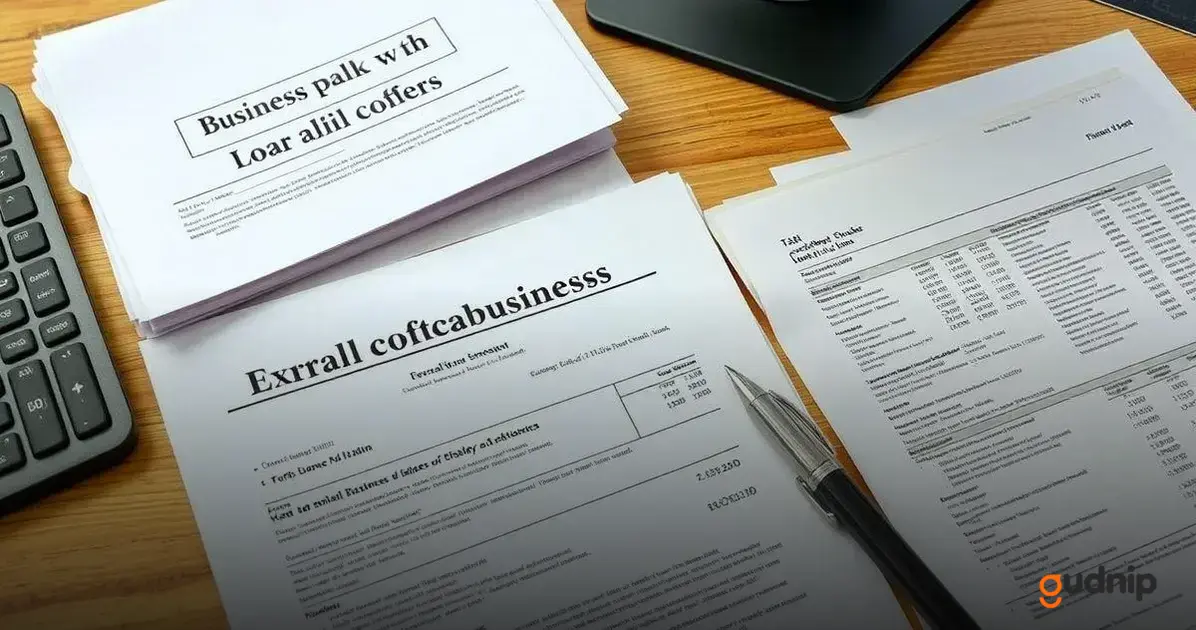To improve your chances of small business loan approval, focus on maintaining a strong credit score and preparing essential documents.
It’s also important to demonstrate cash flow stability and choose the right lender for your business needs.
A clear business plan and honest communication can also strengthen your application.
Securing funding through small business loan approval tips can seem challenging, but with the right strategies, you can navigate this process effectively.
Whether you are a startup or an established business, understanding the requirements and preparing thoroughly can significantly enhance your chances of getting approved.
Understanding Small Business Loans
Understanding small business loans is crucial for any entrepreneur seeking funding.
Small business loans are financial products designed to provide capital to small and growing businesses.
These loans can help support various needs, from purchasing inventory to paying for marketing efforts.
Types of Small Business Loans
There are different types of loans available to small businesses.
The most common include traditional term loans, which are repaid in fixed monthly installments, and lines of credit, which allow businesses to borrow up to a certain limit.
Who Qualifies for a Small Business Loan?
Qualification for a small business loan generally depends on factors such as credit score, time in business, and revenue.
Lenders often look for a solid business plan and how well you can demonstrate your ability to repay the loan.
The Application Process
The application process for small business loans can vary by lender.
Typically, applicants need to fill out forms and provide documentation about their business’s financial history and projections.
Interest Rates and Fees
Interest rates and fees play a crucial role in understanding small business loans. Rates can vary significantly based on the lender and the borrower’s creditworthiness.
Always be sure to read the fine print to know what fees may apply.
Benefits of Small Business Loans
One of the main benefits of small business loans is the ability to access capital quickly.
This funding can be used for essential investments that help in growing your business.
Common Mistakes to Avoid
Businesses often make mistakes when applying for loans, such as not preparing enough documentation or not understanding their financial needs.
It’s important to do research and prepare adequately.
The Importance of Strong Credit
The importance of strong credit cannot be overstated when applying for small business loans.
Lenders often use credit scores as a key factor in deciding whether to approve a loan application.
A strong credit score indicates that a business has a history of good financial management.
What is a Credit Score?
A credit score is a numerical representation of a business’s creditworthiness.
It is typically calculated based on payment history, amounts owed, credit mix, and new credit inquiries.
Understanding this score can help you improve your chances of loan approval.
Why Strong Credit Matters
Having a strong credit score can result in lower interest rates and better loan terms.
Lenders view businesses with strong credit as lower risk, which can lead to significant savings over the life of the loan.
How to Improve Your Credit Score
Improving your credit score involves paying bills on time, reducing debt, and monitoring your credit report for errors.
Regularly reviewing your credit allows you to catch and correct inaccuracies.
Building Business Credit
Establishing business credit is different from personal credit.
Open business credit accounts and ensure that your vendors report your payment history to credit bureaus. This will help you build a strong business credit profile over time.
The Impact of Poor Credit
If your credit score is low, you might face higher interest rates or even loan denial. This can limit your business’s growth potential and result in missed opportunities.
This is an Ongoing Process
Maintaining a strong credit score is an ongoing process that requires careful planning.
Regularly assess your financial health and take proactive steps to keep your credit in good standing.
Preparing Essential Documents

Preparing essential documents is a crucial step in the small business loan application process.
Lenders require various forms of documentation to assess the financial health and stability of your business.
Being organized and having these documents ready can significantly improve your chances of loan approval.
1. Business Plan
A comprehensive business plan outlines your business objectives, strategies for achieving them, and financial forecasts.
This document demonstrates your readiness and thoughtfulness as a business owner.
2. Financial Statements
You need to provide three years of financial statements, including income statements, balance sheets, and cash flow statements.
These documents showcase the past performance and viability of your business.
3. Tax Returns
Including personal and business tax returns for the last two to three years helps lenders evaluate your financial history.
It is important to be transparent about your earnings and tax obligations.
4. Business Licenses and Permits
Make sure to include copies of your business licenses and permits.
This documentation shows that your business operates legally and complies with local regulations.
5. Personal Financial Statements
Most lenders request personal financial statements of the business owners. This provides additional insight into your personal financial health and responsibility.
6. Collateral Documentation
If you are applying for a secured loan, be prepared to provide documentation regarding the assets you are offering as collateral.
This can include property deeds, equipment titles, or inventory records.
7. Bank Statements
Providing recent bank statements helps lenders see your cash flow situation. This is crucial for assessing your ability to manage repayments.
8. Resume or Background Information
Including a resume or background information can be beneficial.
It helps lenders understand your experience and skills as a business owner, building their confidence in your capabilities.
Creating a Solid Business Plan
Creating a solid business plan is essential for securing a small business loan.
A well-crafted business plan outlines your business goals and how you plan to achieve them.
This document is often a deciding factor for lenders, as it demonstrates your foresight and readiness.
1. Executive Summary
The executive summary is the first part of your business plan and provides a high-level overview.
Include your business name, location, and a brief description of what you do. Make it compelling to grab the reader’s attention.
2. Business Description
In this section, detail what your business does, its mission, and what sets it apart from competitors. Also include outlines of your products or services offered.
3. Market Analysis
A thorough market analysis shows you understand your industry, the target market, and your competitors.
Include statistics and trends that support your business idea. This helps lenders see the potential for success.
4. Organization and Management
Explain your business structure, whether it’s a sole proprietorship, partnership, or corporation.
Include information about your team and their qualifications, highlighting the skills that contribute to your business’s success.
5. Marketing Strategy
Your marketing strategy should outline how you plan to attract customers. Discuss promotional tactics, pricing strategies, and sales plans.
This section should convey how you intend to grow your business.
6. Funding Request
Clearly state how much funding you need and how you intend to use it. Be specific about whether you need funds for equipment, working capital, or other expenses.
This section should also include the proposed terms.
7. Financial Projections
Provide financial projections for the next three to five years, including income statements, cash flow statements, and balance sheets.
These figures should be realistic and grounded in research.
8. Appendix
Include any additional information in the appendix, such as resumes, permits, and legal documents, that you want to support your proposal.
This provides lenders with all the details for their review.
Demonstrating Cash Flow Stability
Demonstrating cash flow stability is crucial for securing a small business loan.
Lenders want to see that your business can manage its finances effectively and has the ability to repay the loan.
A positive cash flow indicates that you have more money coming in than going out.
1. Understanding Cash Flow
Cash flow is the net amount of cash and cash-equivalents moving into and out of your business.
A healthy cash flow allows your business to meet its obligations, such as paying bills, wages, and repaying loans.
2. Create a Cash Flow Statement
A cash flow statement is essential to tracking the cash inflow and outflow.
This document will show your operating, investing, and financing activities over a specific period, providing lenders with a clear view of your cash management.
3. Monitor Your Cash Flow Regularly
Regularly monitoring cash flow helps you spot trends, manage expenses, and anticipate any potential shortfalls.
It’s good practice to review your cash flow at least monthly.
4. Maintain Detailed Financial Records
Accurate financial records are key to demonstrating cash flow stability.
Keep organized documents for income and expenses, bank statements, and invoices to show consistency in your financial dealings.
5. Build a Cash Reserve
Having a cash reserve can provide a safety net during slower periods. This reserve can reassure lenders that you are prepared for unexpected cash flow challenges.
6. Improve Cash Flow Management
Consider improving cash flow management by speeding up invoicing, offering discounts for early payments, and managing inventory effectively.
All these strategies can help maintain a steady cash flow.
7. Show Consistency Over Time
Lenders are more likely to approve loans when you can demonstrate consistent cash flow stability over time.
Provide historical cash flow statements to show your track record.
8. Practice Transparency
When applying for a loan, be transparent about your cash flow situation.
If there are fluctuations, be prepared to explain why and how you plan to manage them in the future.
Choosing the Right Lender

Choosing the right lender is a critical step in obtaining a small business loan.
Not all lenders are the same, and finding the best fit for your needs can greatly impact your business’s financial future.
1. Understand Your Options
Start by exploring various lending options, including traditional banks, credit unions, online lenders, and peer-to-peer lending platforms.
Each type of lender has different requirements and benefits.
2. Compare Interest Rates
Compare interest rates from multiple lenders. A lower interest rate can save you a significant amount of money over the life of the loan.
Make sure to look at both fixed and variable rates to find what suits you best.
3. Review Terms and Conditions
Carefully read the terms and conditions each lender offers. Pay attention to the length of the loan, repayment schedules, and any fees associated with the loan.
4. Check Lender Reputation
Research potential lenders to check their reputation. Look for reviews, ratings, and testimonials from other business owners to gauge their experiences.
5. Evaluate Customer Service
Strong customer service can make a big difference when you have questions or issues.
Consider lenders that offer good support, including personal contacts and easy communication channels.
6. Look for Flexibility
Every business is unique. A lender that offers flexible loan options and repayment plans may be more suitable for meeting your specific financial needs.
7. Ask About Prepayment Penalties
Inquire whether the lender has prepayment penalties.
Being able to pay off your loan early without penalties can save you money on interest if your cash flow improves.
8. Seek Recommendations
Seek recommendations from fellow business owners or financial advisors.
Personal experiences can provide valuable insights into which lenders are trustworthy and supportive.
9. Trust Your Instincts
Finally, trust your instincts. If a lender does not feel right to you, or if their terms seem too good to be true, consider looking elsewhere.
Understanding Loan Terms and Conditions
Understanding loan terms and conditions is vital when seeking a small business loan.
Each lender may have different policies, and knowing what these mean can help you make informed decisions.
1. Interest Rate
The interest rate is the cost of borrowing money, expressed as a percentage. It can be fixed or variable.
A fixed rate stays the same over the loan term, while a variable rate may change based on market conditions.
2. Loan Term
The loan term is the length of time you have to repay the loan. Terms can range from a few months to several years.
A longer term often means smaller monthly payments but can lead to paying more interest over time.
3. Monthly Payments
Monthly payments are what you’ll need to pay back each month during the loan term.
This amount is based on the loan amount, interest rate, and term length. Make sure the payment is manageable within your cash flow.
4. Fees and Charges
Many loans come with fees, such as origination fees, application fees, and late payment fees.
Understanding these charges can help you avoid surprises and calculate the true cost of the loan.
5. Collateral Requirements
Some loans require collateral, which is an asset used to secure the loan.
If you fail to repay the loan, the lender can take the collateral. It’s essential to know what you may need to risk.
6. Prepayment Penalties
Some lenders charge a fee if you pay off your loan early.
Understanding prepayment penalties is crucial, especially if you plan to refinance or pay off the loan sooner than expected.
7. Default Conditions
Default conditions outline what happens if you don’t make payments on time. This can include fees, increasing debt, or legal repercussions.
Always ask about these terms before signing the loan agreement.
8. Grace Periods
A grace period is a time frame after the due date during which you can make a payment without penalties.
Not all loans offer grace periods, so it’s important to know if this applies to your loan.
9. Loan Agreement
The loan agreement is a legal document that outlines all terms and conditions of the loan.
Always read this document thoroughly and ask questions about anything you don’t understand.
Applying for Multiple Loans
Applying for multiple loans can be a strategic way to secure the financing you need for your business.
However, it requires careful planning and consideration to avoid potential pitfalls.
1. Assess Your Needs
Before applying for multiple loans, accurately assess how much funding you require and what each loan will be used for.
This helps you avoid unnecessary debt and keeps your finances organized.
2. Understand Lender Policies
Different lenders have different policies regarding multiple loan applications. Some may view this as a red flag, while others may support it.
Be sure to check with each lender about their stance.
3. Maintain Good Credit
Applying for multiple loans can impact your credit score, especially if you receive multiple hard inquiries.
Ensure your credit is in good shape before applying to maximize your chances of approval.
4. Be Transparent with Lenders
When applying for multiple loans, it is important to be transparent with your lenders. Disclose that you are seeking additional financing.
This can help build trust and may improve your approval chances.
5. Keep Track of Payments
Juggling multiple loans means keeping track of various payment dates and amounts.
Use a calendar or financial management app to stay organized and ensure timely payments to avoid penalties.
6. Evaluate Terms and Conditions
Every loan comes with unique terms and conditions. Review these carefully to understand your obligations.
Look out for fees, repayment terms, and interest rates to avoid being overwhelmed.
7. Seek Professional Advice
If you are unsure about applying for multiple loans, consider seeking advice from a financial advisor.
They can provide guidance tailored to your specific situation and needs.
8. Be Cautious of Overextending
While it can be tempting to secure as much funding as possible, be cautious not to overextend yourself.
Manageable debt is key to maintaining a healthy financial position.
9. Monitor Your Financial Health
Regularly review your financial situation to ensure you can handle multiple loan repayments.
Stay informed about any changes in cash flow and adjust your budget accordingly.
Tips for Improving Approval Chances

Tips for improving approval chances for a small business loan can make a significant difference in securing the funding you need.
Consider the following strategies to enhance your chances of approval.
1. Check Your Credit Score
Before applying for a loan, check your credit score. A higher score improves your chances of approval and can lead to better interest rates.
If your score needs improvement, work on paying down debts and making timely payments.
2. Prepare Necessary Documentation
Gather all essential documents like tax returns, financial statements, and a business plan before applying.
Having organized paperwork ready will show lenders that you are serious and prepared.
3. Create a Solid Business Plan
A comprehensive business plan outlines your goals, strategies, and financial projections. It demonstrates to lenders that you have a clear vision and the means to succeed.
4. Demonstrate Cash Flow Stability
Show lenders that your business has a stable cash flow. Providing financial statements that illustrate consistent revenue will increase your credibility and appeal.
5. Choose the Right Lender
Different lenders have different requirements and specialties. Research to find one that aligns best with your business profile and needs.
This can increase your chances of a successful application.
6. Be Transparent
If there are any irregularities in your financial history, be upfront about them.
Lenders appreciate honesty and may be willing to work with you if you explain your circumstances clearly.
Wrapping Up: Your Path to Small Business Loan Approval
Securing a small business loan can be a pivotal step in growing your business.
By understanding the loan process, improving your credit, preparing necessary documents, and choosing the right lender, you can significantly enhance your chances of approval.
Demonstrating cash flow stability and creating a solid business plan are essential factors that lend credibility to your application.
Additionally, being strategic in applying for multiple loans and following specific tips for improving your approval chances can lead to successful outcomes.
With these strategies in place, you can unlock funding success and propel your business toward growth and innovation.





